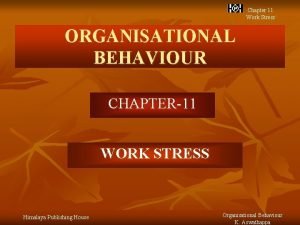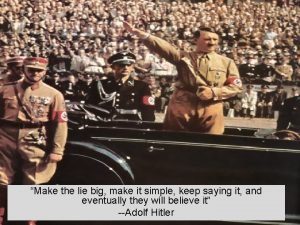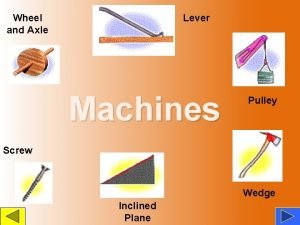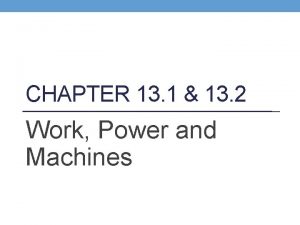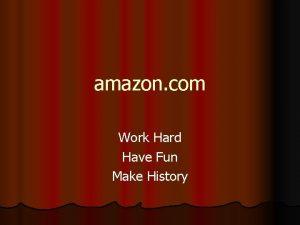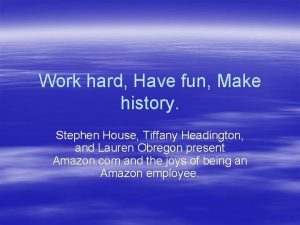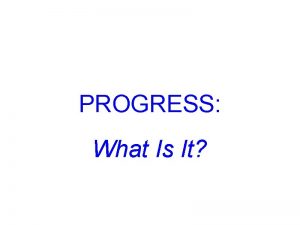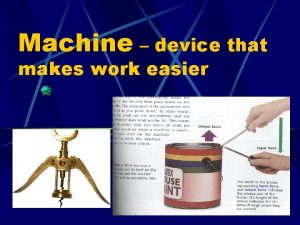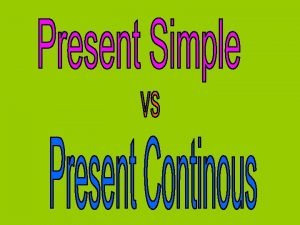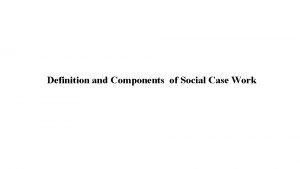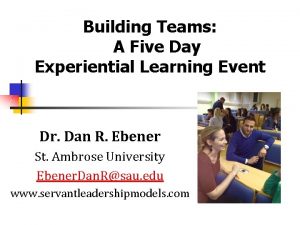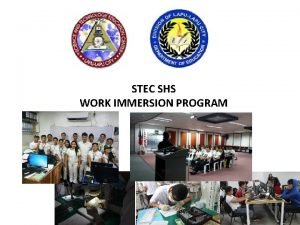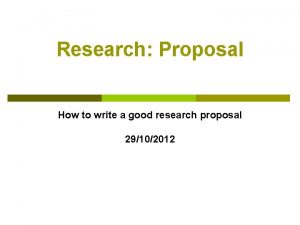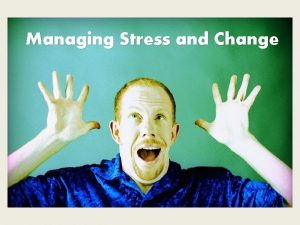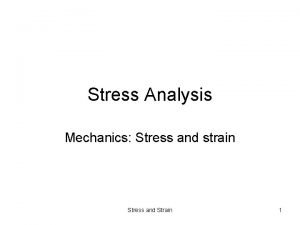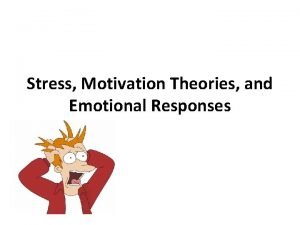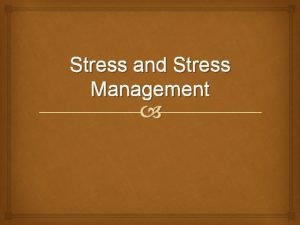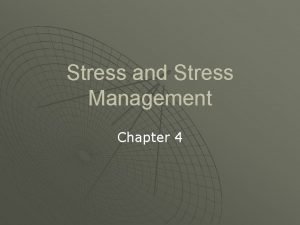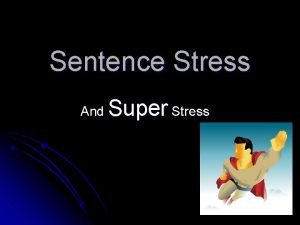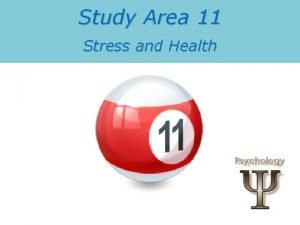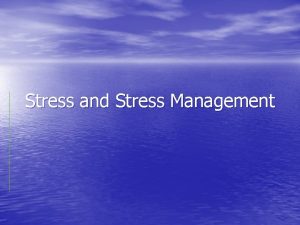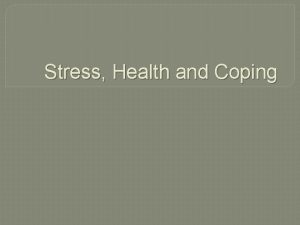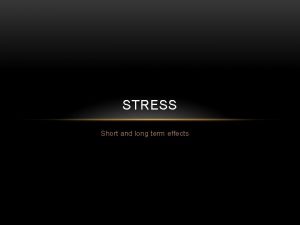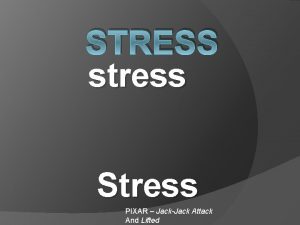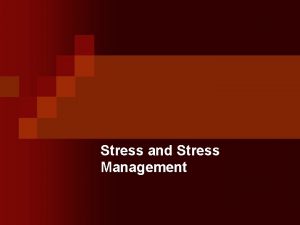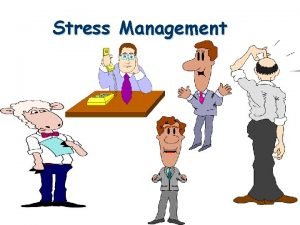TIME AND STRESS How to make time work
































- Slides: 32

TIME AND STRESS How to make time work for you

We use time to solve problems and create results To problem solve we must think critically. There are tools and skills that people use to be good at critical thinking. Critical thinking is a skill-set.

Definition of Critical Thinking “ The application of diverse methods of mental processes to learn, solve problems, create or decide. ” We will cover 5 key points today

Five Key skills of Critical Thinking 1. Be aware of your interior responses-Mental, physical and emotional-E. Q. 2. Understand the desired end result and describe it in SMART terms. 3. Analyze the GAP between where you are with regard to desired end and where you want to be. 4. Know that resources are finite (time, stress, energy, other’s help) but the mind’s creativity is infinite. 5. Evaluate progress against end result and put progress into time tool.

Once you know the end result You can begin to skillfully use time. Problem solving process starts with describing the gap between here and there. Time is one of the critical dimensions of problem solving. Let’s explore how time and stress work together.

Four Factors that impact time 1) 2) 3) 4) Factors that are intrinsic to the individualpersonality, stress response. Factors that are inherent within relationshipscontracting, negotiating and committing. Factors that are intrinsic to corporate culturework processes, rewards for truthful commitment -making. Factors that are external to the individual and the organization- external forces like boards, community-stakeholders.

Time and Perception are tied Sometimes it just feels like our lives are Governed by a stopwatch

And other times it seems like we have all the time in the world-why?

Excellent time management = Positive attitude about your influence Understanding and working with your personality. How we respond versus react to stress Understanding how to prioritize

Exercise #1 Understanding how personality impacts time management: Are you a J or a P on the final letter of your profile? How strong is the score on the J or the P? What is your score on the S or N-strength of score? Are you an E or I? How strong was the preference?

The Stress-response and Time ① ② ③ ④ ⑤ Key Points Stress is change and all change is stressful. Stress is experienced as positive or negative based upon individual perception. Time is perceived as being enough or urgent and not enough based upon perception. Time becomes a negative stress due to perception. You can change your perception by changing your physiology.

Recall a time when: You felt like you were under the gun. You felt like you had all the time in the world. You knew you could get it done. There seemed like too much to do. You found more time than you thought you had. You went from feeling relaxed to distressed and nothing had changed. Time seemed to stand still.

An exercise in time-less-ness Deep relaxation training can improve time management. Since perception is the father of action- it is imperative to influence perception. Relaxation can alter perception of having enough time. Relaxation Response cuts off the fight/flight/freeze reaction. Let’s do a short practice now.

Who owns your time? TIME OWNERSHIP Your manager The team Stakeholders

Discretionary time is what you say it is We give away our time whenever we say yes. We all think that we have less time under our control than we do in fact. How we conceive of time is measured by what is in your calendar. You can look in your calendar and see what you think is important. If you don’t have a time tool then your time is everyone else’s!

Exercise #2 Analyzing how we use time: A. Review your calendar and categorize the top four buckets that your time goes into. B. How does that happen- what is the system, method or practice that you use to allocate time into categories? C. What is the relationship between your calendar and your goals- 50/50? 100? /less?

Tips for Time o o o Make commitments in SMART terms When there is a time commitment look first to see how it impacts existing agreements. Place time in Time Tool proactively. Each week, plan the next with first things first. Make what is first important not just urgent. Your calendar should be what holds what you value.

Time and relationships Who do you think you can say no to and why? Whom do you feel you have to say yes to and why? Who do you have the hardest time negotiating a commitment with and why? How do you make commitments-are they thought out and made in a precise manner?

ICANN Culture and Time ICANN company culture contributes to time pressures: q Lack of planning discipline coupled with trimester focus. q Competing priorities from internal and external sources. q Saying no is not de rigeur. q Urgency not importance is the defining prioritization mode.

Exercise #3 Recall a time when you made a commitment recently that involved your time: Who initiated the request? How was the request made? Where the terms of the request specific? Where the terms of the request measurable? Was it clear what resources were required in terms of time, budget and people? Where the terms of the request time-bound?

Unless a request and a promise are SMART it is not a commitment! How can you place anything in your time tool unless it is specific, measurable, agreed to, resourced and time-bound and feel at all confident about the outcome? What has happened when you commit to anything that is not SMART? How do you make your requests-are they SMART?

Exercise #4 1. 2. 3. 4. Practice drill Think of a commitment that you must make or ask for in the next few weeks- write down now what the commitment is to be? Turn the commitment into either a SMART request or Promise now-write it out in the next 5 min. Partner with someone and share your SMART commitment. Coach each other on how precise the SMART is or is not.

First things first-mistaking urgent for important http: //en. wikipedia. org/wiki/First_Things_First_(book) We all make the mistake of doing what is urgent not necessarily important. How to distinguish the two? First key things to understand are: • We are not in control of our lives. We can choose to let our daily life be governed by principles, rather than a clock. • Leading a principlecentered life means not taking any short cuts or quick fixes. You must follow a path that focuses on why you are doing things rather than how fast or efficiently you are getting things done. • Be willing to examine your life, your motives, and your First Things.

What moves you? What is first for you? What could be more of a priority if you had time? What would you do less of if you had six months to live? What would you do more of if you knew there were not all the time in the world?

What guides us? Two powerful tools direct us: • The clock represents our commitments, appointments, schedules, goals, and activities. • The compass represents our vision, values, principles, mission, conscience, direction, and what we feel is important- how we lead our lives.

No one on their death bed says: “I wish I had worked more. ”

Seven Actions that improve lives Think on this What is the one activity you know if you did superbly well and consistently would have significant positive results in your personal life? • What is the one activity you know if you did superbly well and consistently would have significant and positive results in your professional life? • Improving communication with people • Better preparation • Better planning and organizing • Taking better care of self • Seizing new opportunities • Personal development • Empowerment

Exercise #5 What do you do best at work? What percent of time do you do that? What do you spend time on that you are not very good at? How could you do less of that? What projects or tasks put you in line with doing your best?

Three Circles of your life-#1 Priority in each circle My worklife Vision and Mission- A whole life Relationships, Friends and Family Self-development. Physical/Emotional/Spiritual/Mental

Have a first priority in each circle Exercise #6 With regard to your vision of your life- what one thing could you do to clarify what it is? What are you best at? With regard to your relationships-which one (s) needs tending and which needs weeding? What do you want to learn? What do you want to be better at and are willing to invest in?

7 habits of excellent time managers 1. Make commitments in SMART terms 2. When there is a time commitment look first to see how it impacts existing agreements. 3. Place time in Time Tool proactively. 4. Each week, plan the next with first things first. 5. Make what is first important not just urgent. 6. Your calendar should be what holds what you value. 7. Check in regularly with your manager, team to see how your time is impacting them-course correct.

Bibliography http: //bvarchitects. com/user/Covey_1 st_Things_1 st_Bi zsum. pdf http: //en. wikipedia. org/wiki/First_Things_First_ (book) http: //www. davidco. com/ http: //en. wikipedia. org/wiki/Getting_Things_Do ne
 True strain formula
True strain formula Chapter 10 stress responses and stress management
Chapter 10 stress responses and stress management Axial normal stress
Axial normal stress Stress in organisational behaviour
Stress in organisational behaviour Section 4 review physical science
Section 4 review physical science Make the lie big, make it simple
Make the lie big, make it simple Steve angrisano go make a difference
Steve angrisano go make a difference Dawes plan
Dawes plan Start time end time and elapsed time
Start time end time and elapsed time Working hard vs working smart
Working hard vs working smart Physics 03-02 potential energy and conservative forces
Physics 03-02 potential energy and conservative forces Example of a wheel and axle
Example of a wheel and axle Pulley simple machine diagram
Pulley simple machine diagram How does a wedge make work easier
How does a wedge make work easier Work hard have fun make history
Work hard have fun make history Work hard have fun make history amazon
Work hard have fun make history amazon How do machines make work easier
How do machines make work easier Work make free
Work make free Is anything that helps make work easier
Is anything that helps make work easier Introduction of work immersion
Introduction of work immersion Work immersion attendance
Work immersion attendance Work in simple present tense
Work in simple present tense Reciprocal group model
Reciprocal group model Define social case work
Define social case work Work group vs work team
Work group vs work team I work all day i work all night
I work all day i work all night Smart work vs hard work group discussion
Smart work vs hard work group discussion School work immersion coordinator
School work immersion coordinator Where is the setting
Where is the setting Components of research proposal
Components of research proposal Proposal titles examples
Proposal titles examples Denise garcia vilte
Denise garcia vilte What is the definition of a claim in a literary analysis
What is the definition of a claim in a literary analysis



